
Baghdad College of Medicine / 4
th
grade
Student’s Name :
Dr. Mohammed Bassil
Lec. 4
Non-traumatic
urological emergencies
Tues. 12/4/2016
DONE BY : Ali Kareem
2015 – 2016
خاس
ن
ت
س
ل
ا
ل
ر
و
ش
ا
ب
ت
كم
مكتب آشور لالستنساخ
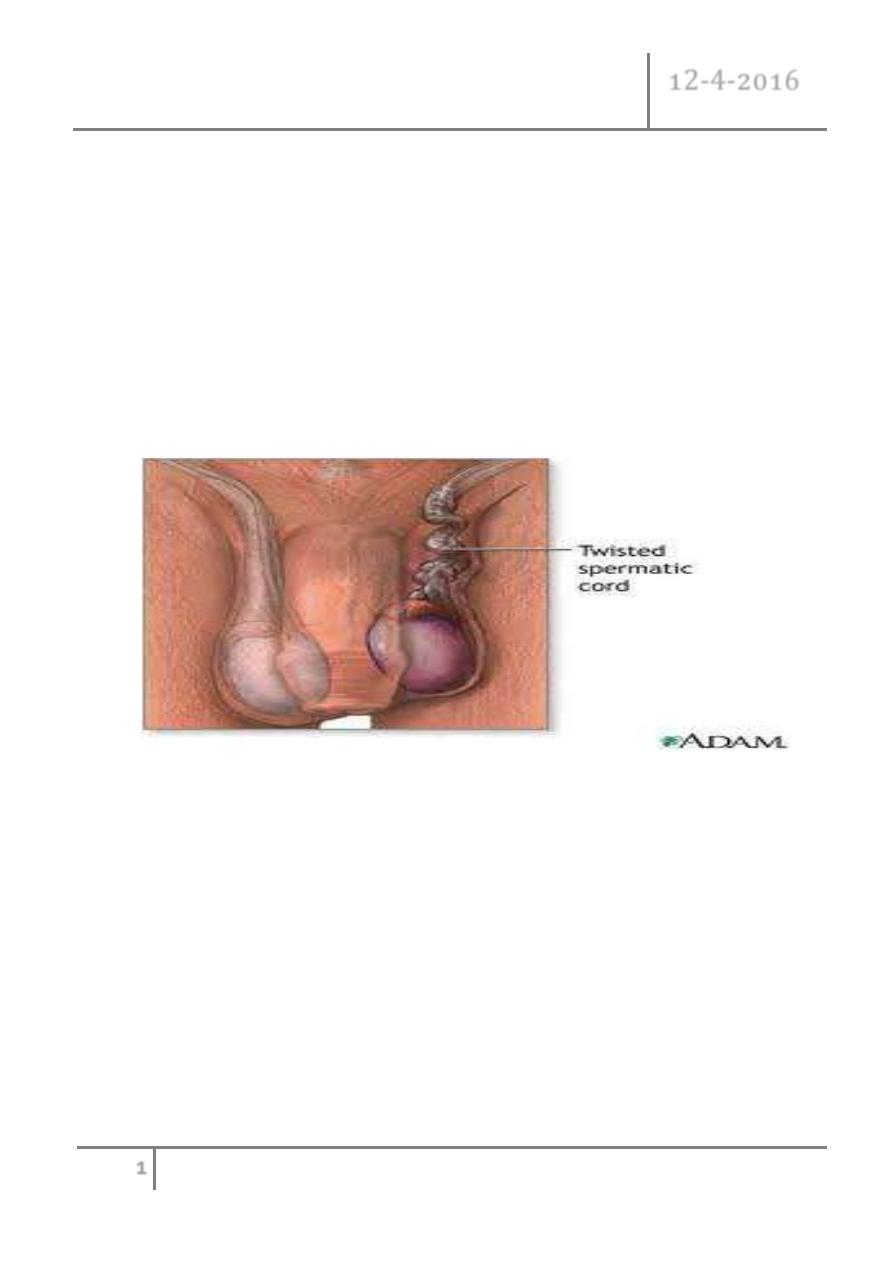
Non-traumatic urological Dr. Mohamed Bassil
emergencies
12-4-2016
1
©
Ali Kareem 2015-2016
Non-traumatic urological emergencies
Torsion of the testis and testicular appendages
Testicular torsion is a twist of the spermatic cord, resulting in strangulation of
the blood supply to the testis.
Most frequently between the ages of 10 and 30 (peak incidence 13–15years of
age), but any age group may be affected.
History and examination
There is a sudden onset of severe pain in the hemiscrotum.
It is often associated with nausea.
There is sometimes a history of minor trauma to the testis.
Some patients report previous episodes with spontaneous resolution of the pain.
The torted testis is usually moderately swollen and very tender to the touch.
It may be high riding compared to the contralateral testis and may lie in a
horizontal position due to twisting of the cord.
Thecremasteric reflex is nearly always absent.
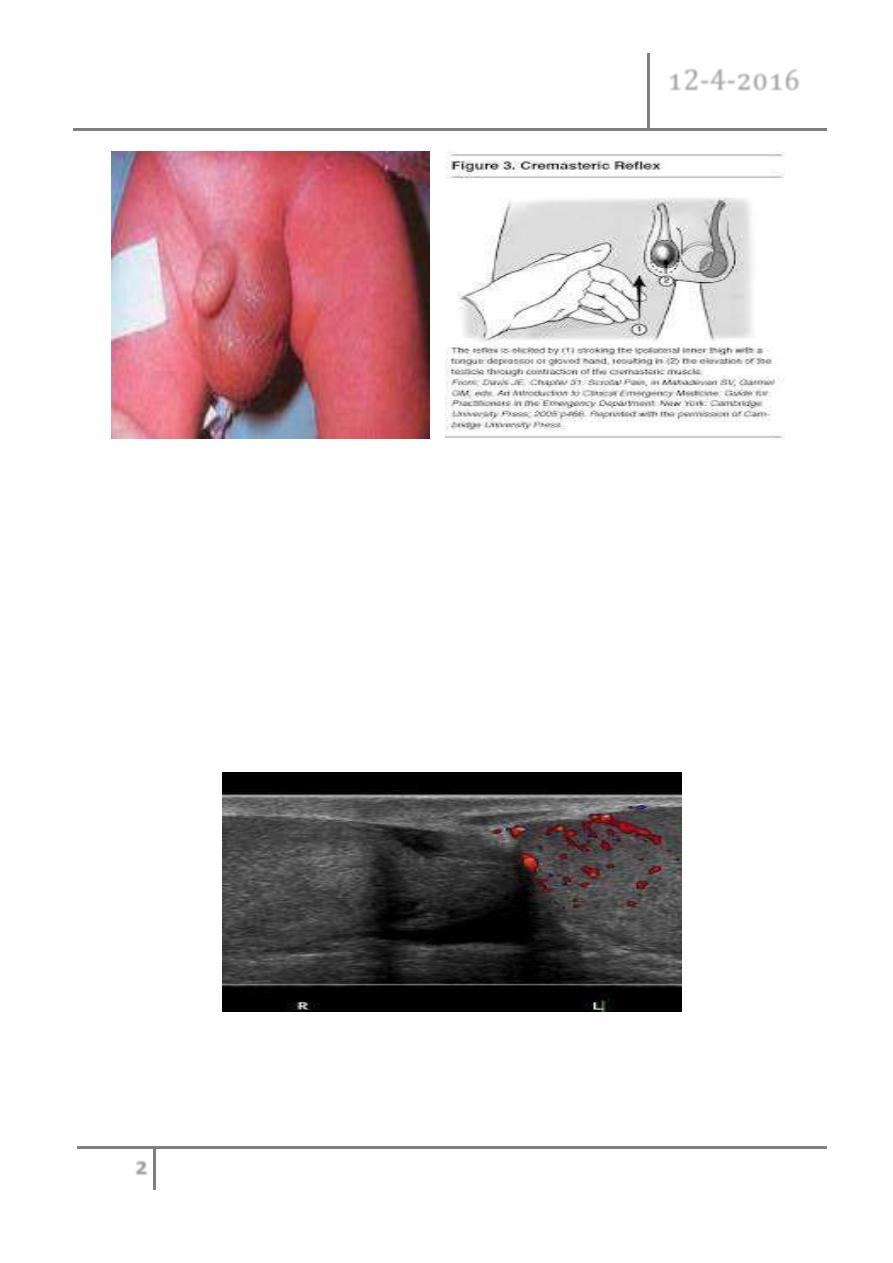
Non-traumatic urological Dr. Mohamed Bassil
emergencies
12-4-2016
2
©
Ali Kareem 2015-2016
Differential diagnosis and investigations
Epididymo-orchitis.
Torsion of a testicular appendage.
Color Doppler ultrasound.
Radionuclide scanning.
In many hospitals these tests are not readily available and the diagnosis is
based on symptoms and signs.
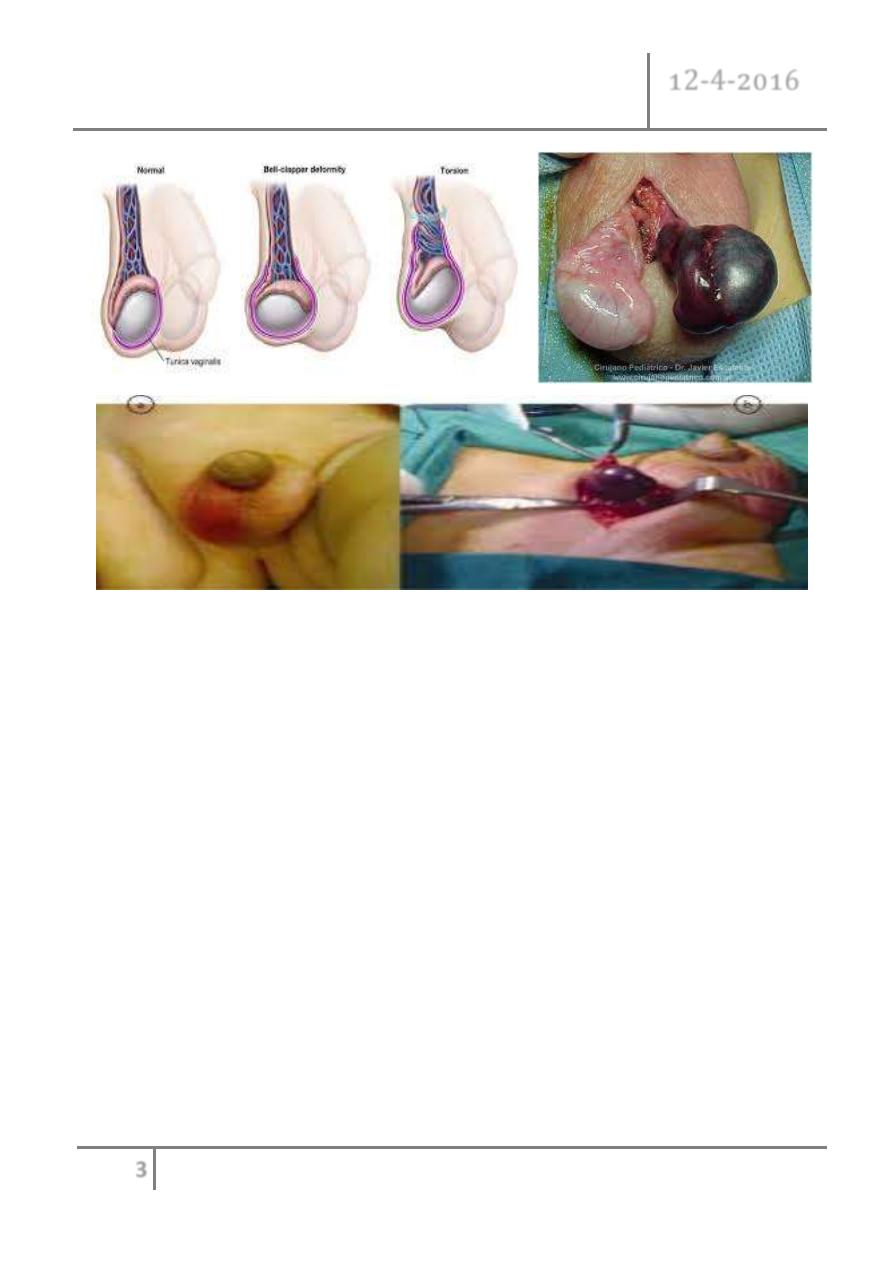
Non-traumatic urological Dr. Mohamed Bassil
emergencies
12-4-2016
3
©
Ali Kareem 2015-2016
Surgical management
Scrotal exploration should be undertaken as a matter of urgency since delay in
relieving the twisted testis results in permanent ischemic damage to the testis,
causing atrophy, loss of hormone and sperm production, and, as the testis
undergoes necrosis and the blood–testis barrier breaks down, an autoimmune
reaction against the contralateral testis (sympathetic orchidopathy).
Bilateral testicular fixation should always be performed since the bellclapper
abnormality that predisposes to torsion often occurs bilaterally.
Manual detorsion may be attempted in the emergency room while awaiting
surgery. Occasionally, the induction of anesthesia will reduce spasm and
promote spontaneous detorsion—in both of these instances,
Bilateral orchiopexy should still be performed to prevent recurrence.
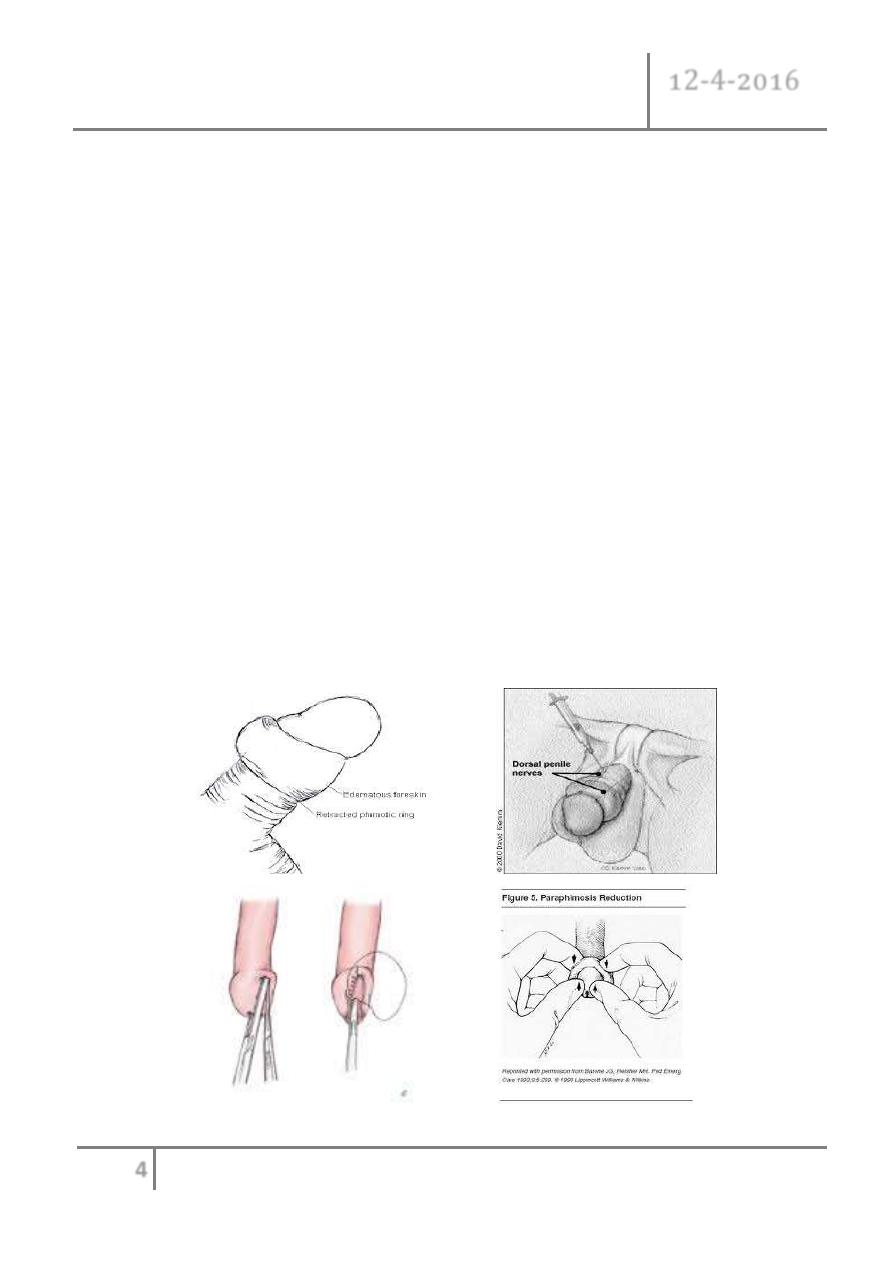
Non-traumatic urological Dr. Mohamed Bassil
emergencies
12-4-2016
4
©
Ali Kareem 2015-2016
Infarction of testicular appendages
The appendix testis and the appendix epididymis can undergo infarction,
causing pain that mimics a testicular torsion.
The “blue dot” sign is the typical physical finding for appendix testis infarction.
At scrotal exploration they are easily removed with scissors or electrocautery.
If these diagnoses are confirmed radiographically, analgesics may be given and
surgical exploration is unnecessary.
Paraphimosis
Is when the uncircumcised foreskin is retracted under the glans penis and the
foreskin becomes edematous, and cannot be pulled back over the glans into its
normal anatomical position.
Paraphimosis is usually painful. The foreskin is edematous and a small area of
ulceration of the foreskin may have developed.
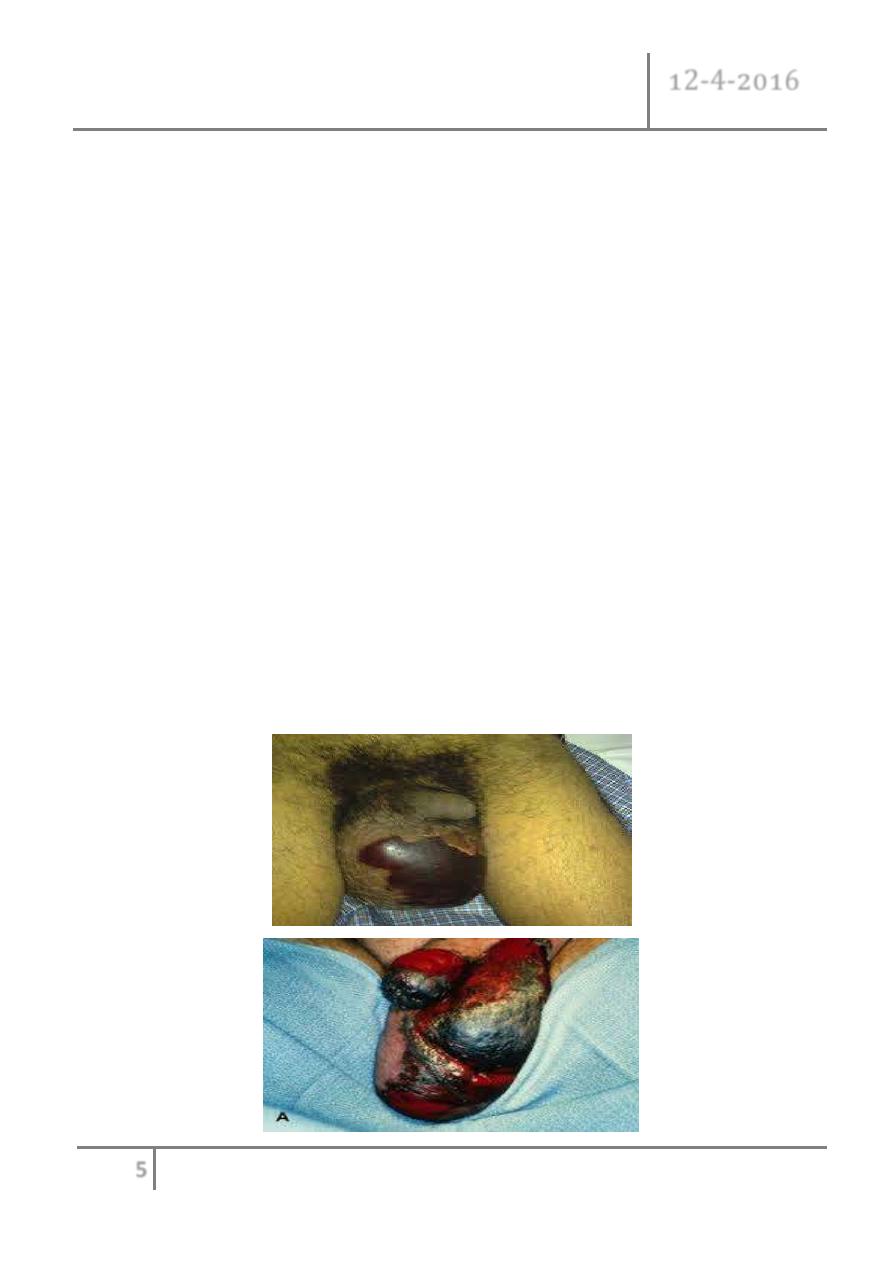
Non-traumatic urological Dr. Mohamed Bassil
emergencies
12-4-2016
5
©
Ali Kareem 2015-2016
Treatment
A. The best initial maneuver for manually reducing paraphimosis is to forcefully
squeeze the edematous prepuce for several minutes. Then the skin may be
manipulated distally with the fingers of both hands as the glans is pressed down
with the thumbs.
B. If this fails, the traditional surgical treatment is a dorsal slit under general
anesthetic or ring block. A longitudinal incision is made in the tight band of
constricting tissue and the foreskin pulled back over the glans.
Fournier gangrene
Fournier gangrene is a necrotizing fasciitis of the genitalia and perineum
primarily affecting males and causing necrosis and subsequent gangrene of
infected tissues.
Culture of infected tissue reveals a mixed polymicrobial infection with aerobic
(E. coli, enterococcus, Klebsiella) and anaerobic organisms (Bacteroides,
Clostridium, microaerophilic streptococci).

Non-traumatic urological Dr. Mohamed Bassil
emergencies
12-4-2016
6
©
Ali Kareem 2015-2016
Presentation
Conditions predisposing to the development of Fournier gangrene include
diabetes, local trauma to the genitalia and perineum (e.g., zipper injuries to the
foreskin, periurethral extravasation of urine following traumatic catheterization
or instrumentation of the urethra), and surgical procedures such as
circumcision.
A fever is usually present, the patient looks very ill, with marked pain in the
affected tissues, and the developing sepsis may alter the patient’s mental state.
The genitalia and perineum are edematous.
And on palpation of the affected area, tenderness and crepitus may be present,
indicating presence of subcutaneous gas produced by gas-forming organisms.
As the infection advances, blisters (bullae) appear in the skin and, within a
matter of hours, areas of necrosis may develop on the genitalia and perineum
that spread to involve adjacent tissues (e.g., the lower abdominal wall).
The condition advances rapidly—hence its alternative name of spontaneous
fulminant gangrene of the genitalia.
Diagnosis
The diagnosis is a clinical one and is based on awareness of the condition and a
high index of suspicion. CT will demonstrate areas of subcutaneous areas of
necrosis and gas.

Non-traumatic urological Dr. Mohamed Bassil
emergencies
12-4-2016
7
©
Ali Kareem 2015-2016
Treatment
Do not delay. While IV access is obtained, blood taken for culture, IV fluids
started, and oxygen administered, broad-spectrum antibiotics are given to cover
both gram-positive and gram-negative aerobes and anaerobes.
Debridement of necrotic tissue (skin, subcutaneous fat) can be carried out.
Extensive areas of tissue may have to be removed.
But it is
unusual for the testes or deeper penile tissues to be involved.
Priapism
Priapism is prolonged and often painful erection in the absence of a sexual
stimulus, lasting >4–6 hours, which predominantly affects the corpus
cavernosa.
Classification
1. Low-flow (ischemic) priapism
- It manifests as a painful, rigid erection, with absent or low cavernosal blood
flow. Ischemic priapism beyond 4 hours requires emergency intervention.
- Blood gas analysis shows hypoxia and acidosis.
2. High-flow (nonischemic) priapism
- This is usually post-traumatic in nature and does not require emergent
intervention. It is due to unregulated arterial blood flow.
- Presenting with a semi-rigid, painless erection.
- Blood gas analysis shows similar results to arterial blood.

Non-traumatic urological Dr. Mohamed Bassil
emergencies
12-4-2016
8
©
Ali Kareem 2015-2016
Management
Ischemic priapism of > 4 hours implies a compartment syndrome and requires
decompression of the corpora cavernosa. Aspiration of blood from corpora ±
intracavernosal injections of α1-adrenergic selective agonist are performed
every 5–10 minutes until detumescence occurs.
High-flow priapism
- Early stages may respond to a cool bath or icepack.
- Delayed presentations require arteriography and selective embolization of
the internal pudendal artery.
Complications
These include fibrosis and impotence.
END OF THIS LECTURE
…
